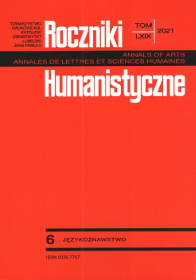O stylistyce i leksyce słów kilka. Potop Henryka Sienkiewicza i słoweński przekład Rudolfa Molè
Some Remarks on Stylistics and Vocabulary: “Potop” (“The Deluge”) by Henryk Sienkiewicz and the Slovenian Translation by Rudolf Molè
Author(s): Agnieszka ZatorskaSubject(s): Language and Literature Studies, Theoretical Linguistics, Lexis
Published by: Towarzystwo Naukowe KUL & Katolicki Uniwersytet Lubelski Jana Pawła II
Keywords: vocabulary; stylistics; translation studies; literary work; Polish language; Slovene language
Summary/Abstract: The aim of this study is to show the ways in which some stylistic marked components were translated in the 1970 Slovenian translation of Henryk Sienkiewicz’s novel “Potop” (“The Deluge”) by Rudolf Molè. The data comprise Latin words, expressive and analytical forms, and names of realia. Choosing the equivalent may result in the loss of stylistic markedness: fatigatus wielce Vol. 1, p. 166. — zelo utrujen Vol. 1, p. 18; — Ni pary z gęby! Vol. 1, p. 40. — Niti besede več!... Vol. 1, p. 44; synalka Vol. 1, p. 365 — sina Vol. 1, p. 394; Daj no waćpan pyska! Vol. 1, p. 203 — Daj, da te objamem! Vol. 1, p. 220. However, many equivalents confirm such stylistic markedness: psubratom Vol. 2, p. 442 — pasjim bratom Vol. 2, p. 476; psiajuchy Vol. 2, p. 442 — pasje duše Vol. 2, p. 476. The translations of historical names demonstrate generalisation, e.g. rajtar vs jezdec, or approximation, e.g. rapier vs meč. The analysis confirms these differences and resemblances between the original and the translation. The general aim of this article is to indicate the stylistic and semantic differences in the translated text.
Journal: Roczniki Humanistyczne
- Issue Year: 69/2021
- Issue No: 6
- Page Range: 189-201
- Page Count: 13
- Language: Polish

